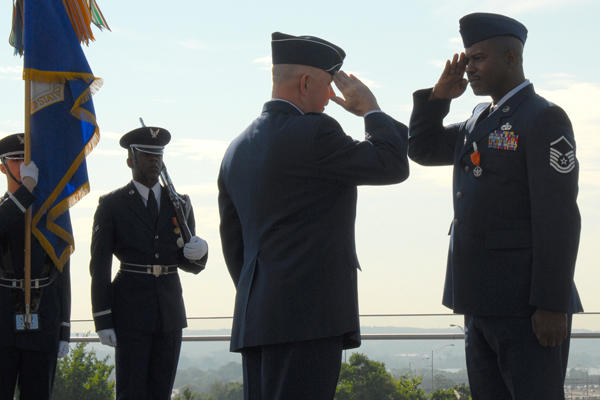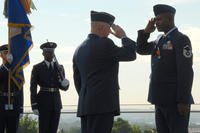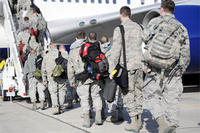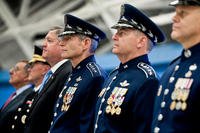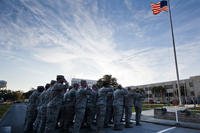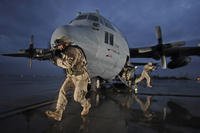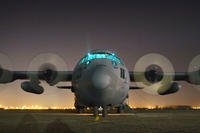Symbols have distinguished friend from foe in warfare throughout recorded history. Organizations of the United States Air Force, like other military organizations, employ heraldic emblems as a means of identification and for esprit de corps. The emblems symbolize the organization's history, mission, or function. Emblematic devices are recorded in the earliest biblical period. Osyris, the grandson of Noah used a "Sceptre Royal, insigned on the top with an eye." 1 In the annals of the Trojan War, the Greeks reportedly sported emblems on their shields. Later, the eagle of the Roman legions, a highly visible symbol throughout the empire, represented the might of Imperial Rome. Indeed, before the Middle Ages, all organized tribes and states accepted and used symbols and heraldic devices. None of these devices were hereditary, but they were the predecessors of medieval heraldry.
Heraldry as we know it today had its beginning in the early 12th century during the period between the First and Second Crusades. To ensure recognition while wearing armor and a helmet that partially hid the face, enterprising knights began to use identifying symbols and devices called cognizances, which were painted on their shields and embroidered on the pennons (cloth banners) attached to their lances. This practice spread rapidly as warriors from different European lands gathered to participate in tournaments and fight in the Crusades. The inheriting of these cognizances started in western Europe during the second quarter of the 12th century when men of the knightly class began to display on their shields the devices that had been borne by their fathers. During the late 12th and early 13th centuries, heraldic emblems and devices assumed a distinctive and consistently systematic character that identified individuals, families, nobles, knights, establishments, and communities. At this time, a knight's cognizance incorporated on his personal seal also became his signature in civil transactions.
Among those who played a part in the history of heraldry, the "herald" was perhaps the most important. Commissioned by the sovereign as his official representative, the herald proclaimed the edicts of the king, carried messages between opposing armies, and issued official proclamations of tournaments and the regulations that governed them. In tournaments, the cognizance that each knight displayed helped the herald distinguish among the mass of armored men. To prevent a knight from duplicating someone else's cognizance, heralds eventually compiled Rolls of Arms that listed the cognizances painted on shields and embroidered on the pennons of the medieval warrior, thereby establishing the system known as heraldry. 2
With the passage of time and technical changes in warfare, the herald became less a public servant and more a genealogist. His role focused increasingly on maintaining the Roll of Arms. By the 13th century, official (that is, recorded) cognizances began to appear on embroidered cloth over the knights' armor as well as on shields and became known as coats of arms. Later the term "coat of arms" became synonymous with the shield, its crest, and its scroll, bearing a name or motto. A description in words of armorial bearings* is a blazon written in the precise language of heraldry to indicate to a reader without an illustration of the coat of arms the exact arrangement and colors of the design on the shield, crest, or scroll. The shield (either heater shaped or circular) is used for displaying armorial bearings in Air Force Heraldry as an identifying mark for an organization. The charges, or figures, that form a coat of arms are emblazoned on the surface of the shield, called the field.
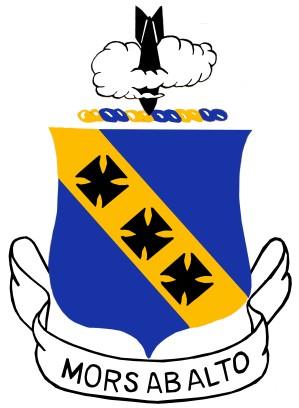
|
Figure 1 provides a historical example of a shield, crest, and scroll. The crest is any device displayed above the shield, and it is placed over a wreath of six skeins or twists composed of the principal metals (gold and silver) and colors of the shield. The metals and colors appear alternately in the order named in the blazon. The scroll is the third element in a military coat of arms and is usually inscribed with a motto and placed beneath the shield.
Symbols in Emblems
The basis of the design of an Air Force emblem involves geometric and/or illustrative visual symbols. Symbols are in common use throughout the world, as a glance at the symbols in Figure 2 illustrates. Who would not recognize the striped pole as symbolizing a barber shop or associate a grocery cart with a food market? A mortar and pestle almost universally represent a pharmacy and the three balls identify a pawn shop. These symbols are among hundreds universally recognized; they require no explanation.

|
Sometimes choices are available among symbols. For example, Aesculapius, the mythical Greco-Roman god of medicine, carried a knotty wooden staff entwined with a snake (Figure 4) representing life-giving powers. This staff was adapted in 1910 for use as the insignia of the American Medical Association. The United States Air Force Medical Service and other medical groups the world over also use this staff to identify the medical profession.
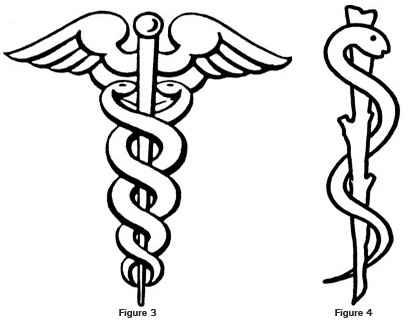
|
On the other hand, the Caduceus (Figure 3), a staff with two snakes coiled around it, was traditionally the symbol of the herald and now is the official symbol of the US Army Medical Corps, Navy Pharmacy Division, and the Public Health Service. This intertwined snake design dates back some 4,000 years to Babylon. It reappeared in Greek mythology with a pair of wings added, as Hermes' wand. In ancient Rome, messengers carried this symbol as a sign of neutrality, the Caduceus establishing their noncombatant status.
Other symbols appear on the following page. These examples hardly exhaust the subject. One should understand, however, that Air Force organizational emblems are not representations of actual aircraft or equipment. Instead they are geometric and/or illustrative visual concepts and design relationships that portray the characteristics and qualities with which an organization associates itself or its current or historic mission.
Air Force Symbols
An organization's emblem design should focus on the organization's primary or historical mission. Find symbols that illustrate the key word in your description. A portcullis, a chain, a geometric pattern suggesting bars, a lock, or a scale of justice can all be symbols representing security. The actual badge and gun used to defend a base are not acceptable heraldic symbols of security. The organization can also include symbols that illustrate the organization's history and that reflect the parent organization and the quality and excellence of its personnel who perform the functions.
Arranging symbols in a visually interesting way is just as important to an effective design as is selecting the right symbol. Quartering a shield or a disc and placing a symbol in each quarter has become a heraldic cliché. There are hundreds of ways to devise a shield in heraldry. The designer should try to avoid the obvious, use imagination, do research, get help from a graphics shop, or ask the Army Institute of Heraldry for assistance. The elements of design, proportion, symmetry, value, and hue make your design interesting. Simple bold designs with contrast are the ones remembered best, not the overly detailed pictorial ones. Such simple designs also result in more striking and recognizable distinctive patches.
Many of us are engaged in military occupations which support the larger Air Force mission. Everyone's job is important and each organization is a vital link in the defense of the country. However, emblem design should not be all encompassing. A good design visually depicts the organization's mission, history, and qualities, in symbolic form, so that members may wear it proudly.
